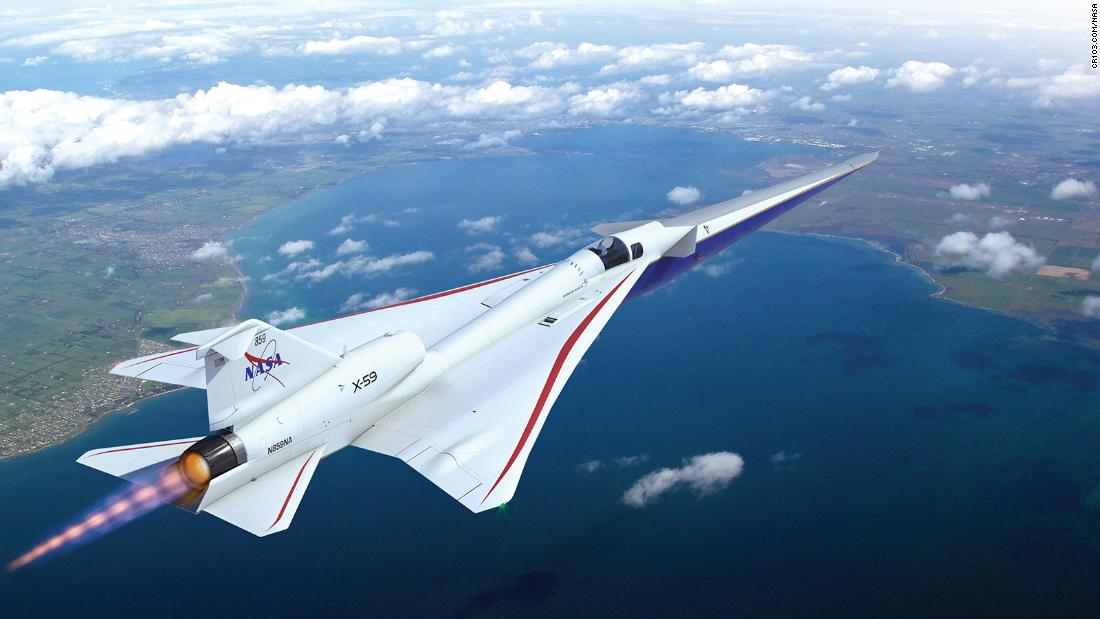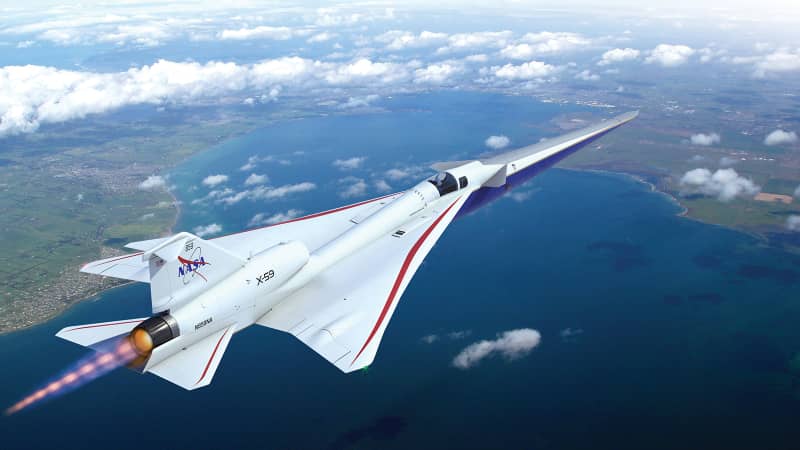(CNN) — If you’ve heard a sonic boom recently, you probably remember it. The loud, explosion-like bang — caused by a plane flying faster than the speed of sound — can be startling, and even crack windows.
Now, NASA is working to change those regulations by transforming the boom into a “thump,” paving the way for a new generation of quieter supersonic aircraft. The agency is doing so through a program called Quesst — for “Quiet SuperSonic Technology” — which is the result of decades of research and is centered around a new aircraft called the X-59.
Distant thunder
“It will be significantly quieter than Concorde or any other supersonic aircraft that exist today,” says Craig Nickol, project manager of the Quesst program at NASA. “It’s extremely long and thin: It’s almost 100 feet long (30.5 meters), but has a wingspan of only about 29 feet. The nose is a distinguishing feature on this aircraft: it’s about a third of the length.”
The sleek shape plays a key role in making the aircraft much quieter when traveling supersonically.
But how does a sonic boom happen? When an aircraft travels at subsonic speeds, the sound waves that it normally creates can travel in all directions; at supersonic speeds, however, the aircraft will leave its own sound behind and the sound waves will compress and coalesce into a single shockwave that originates at the nose and ends at the tail.
When this highly compressed shockwave meets a human ear, it produces a loud boom, which does not occur when the plane breaks the sound barrier, but is rather a continuous effect that can be heard by anyone in a cone-shaped area beneath the plane, as long as it exceeds the speed of sound.
The X-59’s shape is designed to prevent the shockwaves from coalescing together. Instead, they spread out, with the help of strategically placed aerodynamic surfaces. The lone engine is also at the top rather than the bottom of the plane, to keep a smooth lower profile that prevents shockwaves from reaching the ground.
As a result, NASA believes the X-59 will produce just 75 decibels of sound when traveling at supersonic speeds, compared to Concorde’s 105 decibels.
“What that means is that this aircraft may sound like distant thunder on the horizon, or like someone shutting a car door around the corner,” Nickol says. “It may even be that people don’t hear the boom at all, and if they do they will certainly not be startled, because it will be low and spread out, and not that loud at all.”
Changing regulations
The crucial part of the program will start in 2024, when a series of test flights will be performed over half a dozen residential communities across the US, selected to offer a diverse mix of geographic and atmospheric conditions: “That’s going to be a fun part of the project, because we’re going to engage with the public and generate a little bit of citizen science,” says Nickol.
Once the X-59 is flown over the selected areas, NASA will engage with the communities on the ground to gauge their response to the noise. The goal is to confirm the theory that a 75-decibel boom will be acceptable.
The data gathered in this way will then be presented to the International Civil Aviation Organization (ICAO), which is in charge of aircraft noise regulations, to persuade it to update them at an international meeting scheduled for 2028.
A new generation
NASA believes that a change in regulations would open up the skies for a new generation of supersonic aircraft, allowed to fly over routes that aren’t permitted now, such as New York to Los Angeles, and cutting flight time roughly in half.
We don’t know, however, what those aircraft will look like and who will build them, because the X-59 is not a prototype but merely a technology demonstrator.
“Any future design of a low boom commercial aircraft for supersonic flight will certainly be different than this, although some of the design elements could translate directly over,” says Nickol, pointing at the extended nose, some of the flight control systems, and the X-59’s unique external vision system, which provides the pilot with high-definition displays showing what’s ahead, in the absence of an actual forward-facing window due to the aircraft’s streamlined nose.
Nickol believes that such aircraft, with the ability to fly anywhere, would democratize supersonic travel, marking a stark difference with Concorde’s luxury status: “If you look back 100 years, a lot of the advanced mobility technologies, including railroads and airplanes, started out as premium experiences, but as technology advanced and costs came down, they became available to the general public,” he says.
“One of the long-term goals is to make this form of high speed travel available as a widespread application, and there’s really no reason why it can’t happen.”


